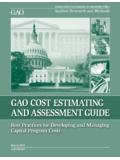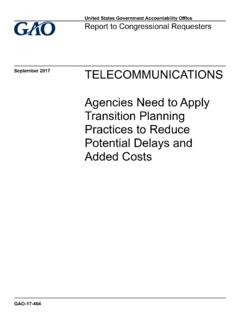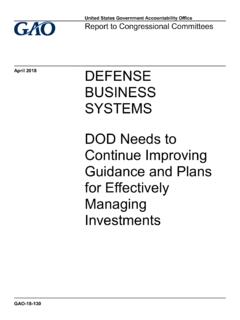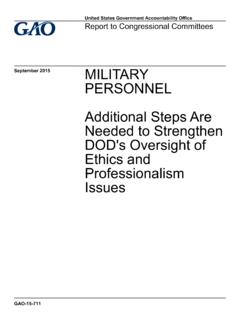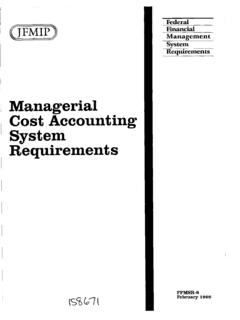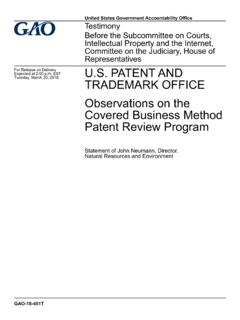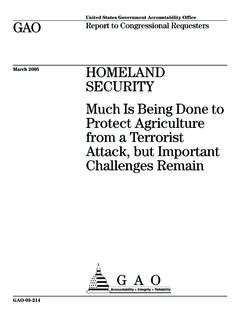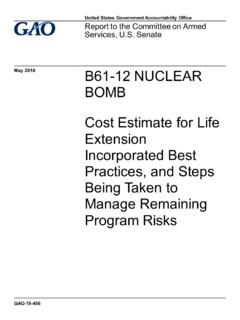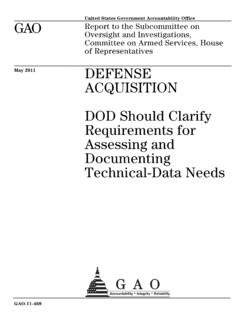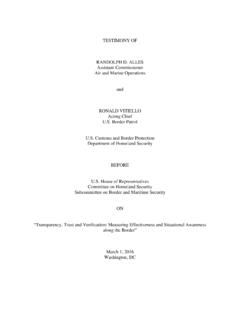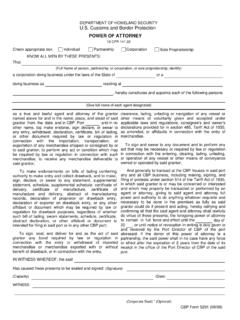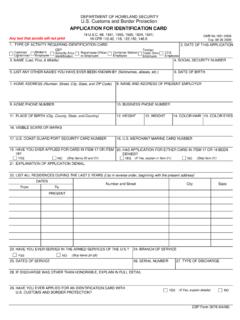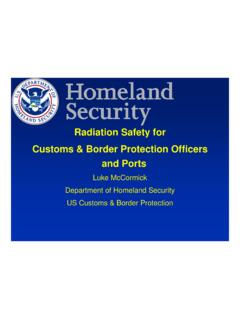Transcription of GAO-18-271, Customs and Border Protection: …
1 Customs AND Border protection Automated Trade Data System Yields Benefits, but Interagency Management Approach Is Needed Report to Congressional Committees March 2018 GAO-18-271 United States Government Accountability Office United States Government Accountability Office Highlights of GAO-18-271, a report to congressional committees March 2018 Customs AND Border protection Automated Trade Data System Yields Benefits, but Interagency Management Approach Is Needed What GAO Found Since renewing efforts to implement the Automated Commercial Environment (ACE) in 2013, Customs and Border protection (CBP) has deployed a number of key ACE activities, processes, and functions that it terms core capabilities.
2 After several delays, CBP reported that it had fin ished implementing these capabilities other than a capability for revenue collections in February 2018. CBP expects to decide how to proceed with collections by the end of March 2018, according to agency officials. Three Stages of Import Processing The 22 agencies CBP identified as requiring documentation to clear or license cargo are all authorized to access ACE, although GAO found considerable variation in their use of the system for import processing. For example, the Food and Drug Administration has integrated its systems with ACE and uses ACE data to review imports under its jurisdiction and target public health risks.
3 In contrast, the Fish and Wildlife Service has not yet integrated ACE into its operations. ACE users at CBP and partner agencies and in the trade community told GAO that using ACE has reduced costs by making trade processing more efficient and has strengthened enforcement of trade laws and regulations. CBP has developed metrics for itself and the trade community and estimated savings that could result from the increased efficiency of some processes in ACE. CBP also reported efforts to expand its metrics to capture more ACE benefits for example, to estimate the value of increased efficiencies for partner agencies. CBP has not yet established an approach for the management of ACE after February 2018.
4 The agency plans to enhance ACE to address shortcomings ACE users have identified such as difficulty in transmitting messages and required information but has not established a process for prioritizing all suggested enhancements. CBP also has not identified funding for continued ACE development, including enhancements, after fiscal year 2018. CBP is leading an interagency effort to develop an ACE management approach that includes processes for prioritizing enhancements and sharing costs, but this approach has not been finalized. Federal guidance calls for establishing the organizational structure necessary to operate effectively and for examining efforts as needed to adopt coordinated approaches.
5 Until processes for prioritizing ACE enhancements and sharing costs are finalized, agencies and the trade community will not realize the system s full potential benefits. View GAO-18-271. For more information, contact Kimberly Gianopoulos at (202) 512-8612 or Why GAO Did This Study CBP began work on ACE in 1994 to update the agency s existing electronic trade processing system. In 2006, Congress broadened this effort by mandating creation of a single portal International Trade Data System to, among other things, efficiently regulate the flow of commerce and more effectively enforce laws and regulations relating to international trade. Performance problems halted implementation of ACE from 2010 to 2013.
6 In 2014, the President set a deadline of December 31, 2016, for completing the system. The Trade Facilitation and Trade Enforcement Act of 2015 included a provision for GAO to report on issues related to ACE implementation. In this report, GAO examines (1) CBP efforts to complete core ACE capabilities since 2013; (2) agencies access to ACE and use of the system to process imports; (3) any cost savings and trade enforcement benefits from using ACE; and (4) the approach that will be used to manage ACE after core capabilities are completed. GAO reviewed information from 22 agencies as well as importers, exporters, and brokers and interviewed agency and trade community representatives.
7 What GAO Recommends The Secretary of Homeland Security should ensure that the Commissioner of CBP, in collaboration with partner agencies, finalizes an interagency approach to managing ACE that includes processes for prioritizing enhancements and sharing system costs. CBP concurred with GAO s recommendation. Page i GAO-18-271 Customs and Border protection Letter 1 Background 4 CBP Has Implemented Core ACE Capabilities but Delayed Completion Several Times 8 Partner Agencies That Clear or License Cargo Have Access to ACE, but Extent of Use Varies 11 ACE Users Report Cost Savings and Enforcement Benefits 20 Approach to Managing ACE after Implementation of Core Capabilities Has Not Been Established 28 Conclusions 39 Recommendation for Executive Action 39 Agency Comments and Our Evaluation 39 Appendix I Objectives, Scope.
8 And Methodology 42 Appendix II Partner Agency Participation in ACE 45 Appendix III Comments from the Department of Homeland Security 56 Appendix IV GAO Contact and Staff Acknowledgments 58 Tables Table 1: Agencies with Responsibility for Clearing or Licensing Cargo That Have Signed Memorandums of Understanding with CBP 11 Table 2: Five Selected Agencies Use of CBP s Automated Commercial Environment (ACE) as Reported by CBP 14 Table 3: Prioritized Enhancements to CBP s Automated Commercial Environment as of September 2017 32 Table 4: Participation in the Automated Commercial Environment (ACE) by CBP Partner Agencies That Require Documentation to Clear or License Cargo 46 Table 5: Participation in the Automated Commercial Environment (ACE) by CBP Partner Agencies That Do Not Require Documentation to Clear or License Cargo 52 Contents Page ii GAO-18-271 Customs and Border protection Figures Figure 1: CBP and Other Agency Roles at Three Stages of Import Processing 5 Figure 2: Timeline Summarizing CBP Efforts to Develop and Deploy Core Automated Commercial Environment (ACE) Capabilities since 2013 10 Figure 3.
9 Numbers of Unaddressed Suggested Enhancements to CBP Automated Commercial Environment, by Source, 2001-2017 30 Figure 4: Estimated Annual Funding Requirements for CBP s Automated Commercial Environment, Fiscal Years 2019-2022 36 Abbreviations ACE Automated Commercial Environment APHIS Animal and Plant Health Inspection Service CBP Customs and Border protection CPSC Consumer Product Safety Commission DHS Department of Homeland Security FDA Food and Drug Administration FWS Fish and Wildlife Service ITDS International Trade Data System NHTSA National Highway Traffic Safety Administration PGA partner government agency SAFE Port Act Security and Accountability For Every Port Act of 2006 TFTEA Trade Facilitation and Trade Enforcement Act of 2015 This is a work of the government and is not subject to copyright protection in the United
10 States. The published product may be reproduced and distributed in its entirety without further permission from GAO. However, because this work may contain copyrighted images or other material, permission from the copyright holder may be necessary if you wish to reproduce this material separately. Page 1 GAO-18-271 Customs and Border protection 441 G St. Washington, DC 20548 March 14, 2018 Congressional Committees Customs and Border protection (CBP) an agency of the Department of Homeland Security (DHS) enforces the Customs and trade laws of the United According to CBP, the agency processes about $3 trillion in trade and collects about $44 billion in revenue each year from import duties, taxes, and fees.
